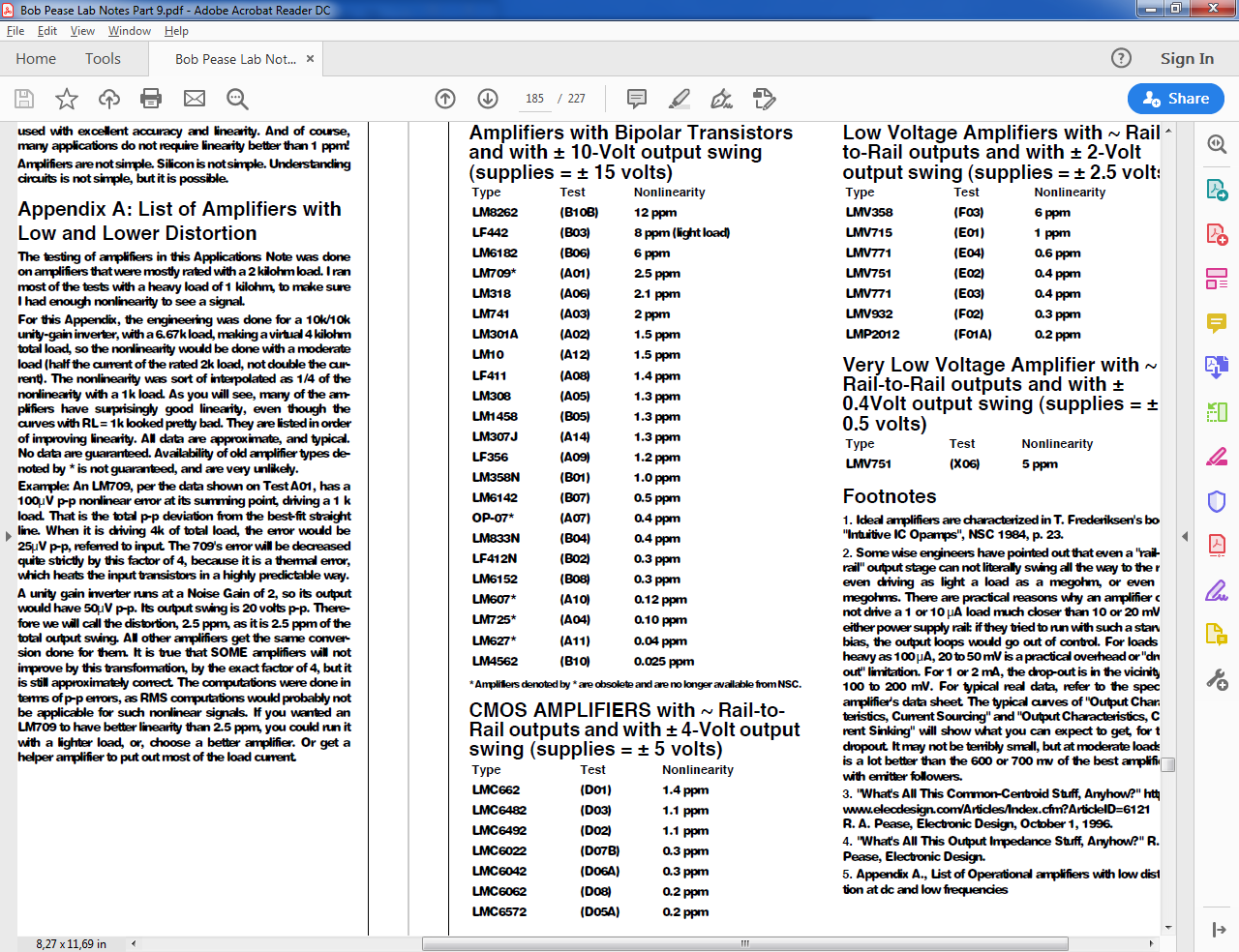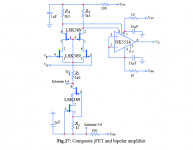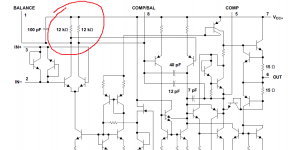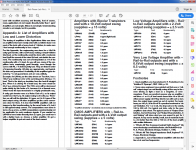I'm refurbishing an old audio circuit that uses LM318 opamps; datasheet does NOT show any THD specs. Has anyone measured these opamps?
Lm318 was one of the best, low distortion, high open loop gain, high slew rate, quality devices of it's time.
Like : it's been used in distortion analyzers like HP339a etc..
I have never measured it stand-alone, but in the Myref composite amps of Mauro Penasa, applied as input stage / control amp. The obtained results were put on here, at around 0,00015% up to close to clipping.
Ciao, George
Like : it's been used in distortion analyzers like HP339a etc..
I have never measured it stand-alone, but in the Myref composite amps of Mauro Penasa, applied as input stage / control amp. The obtained results were put on here, at around 0,00015% up to close to clipping.
Ciao, George
The LM318 is a fast Opamp for instrumentation with a small signal bandwidth of 15MHz. It is NOT meant for audio use. Noise or THD are not critical in general application Opamp. National Semiconductor designed the NE5534/5532 series for audio which was very successful, but has since been superseded by better Opamp.I'm refurbishing an old audio circuit that uses LM318 opamps; datasheet does NOT show any THD specs. Has anyone measured these opamps?
You can find information on measuring and reducing noise for LM318 in this old National Semiconductor application note that TI re-published.
http://www.ti.com/lit/an/snla206a/snla206a.pdf
The major issue against using LM318 in audio because it has poor damping, or in other word,it rings. The transient response of LM318 is poor, but perfectly acceptable in wide band, steady state, instrument type measurement application. If you want something faster and quieter than NE5534 (5V/uS), the LME49710 (20V/uS) is a good choice, but somewhat expensive.
Last edited:
National Semiconductor designed the NE5534/5532 series for audio which was very successful, but has since been superseded by better Opamp.
Just a point of fact - it was Philips who developed the TDA1034 which later was renamed NE5534 (a Signetics ID).
http://www-f9.ijs.si/~margan/Audio/Ironing_RIAA.pdf
page 37-38 and your riaa pre too 😉 i wouldn't go fet all the way , bipolars are better for CCS and cascode transistor, but you're a smart guy 🙂
page 37-38 and your riaa pre too 😉 i wouldn't go fet all the way , bipolars are better for CCS and cascode transistor, but you're a smart guy 🙂
Attachments
Bob Pease tested its linearity (heavily related to distortion), and it doesn't come out very well: it is one of the worst he tested, ranking between the 709 and 741:

In addition, as already mentionned, its noise and dynamic behavior are problematic in many instances
In addition, as already mentionned, its noise and dynamic behavior are problematic in many instances
Attachments
While I do not wish to argue much, because basically You are right - It turns out from the text that the measurement was done at the 2k load zone. So the output stage is heavily involved. And as he points out, at lighter loads the values can get much better.
Just trying to understand why I did get much better distortion results than from this test could be projected. (the load in the Myref topology is 47Kohm). And it did get applied in precision low frequency oscillators like Krohn Hite, distortion meter like that Hp339A etc.
Just trying to understand why I did get much better distortion results than from this test could be projected. (the load in the Myref topology is 47Kohm). And it did get applied in precision low frequency oscillators like Krohn Hite, distortion meter like that Hp339A etc.
Wow, that's interesting---318 not very good at all! I see that the LM4562 fared quite well----was there any mention of the NE5534's performance?Bob Pease tested its linearity (heavily related to distortion), and it doesn't come out very well: it is one of the worst he tested, ranking between the 709 and 741........In addition, as already mentioned, its noise and dynamic behavior are problematic in many instances
Well, I am thinking that the venerable NE5534A would be the go-to here. It's hard to beat its combination of low noise (3.5nV√Hz, 0.4pA), low distortion (-94db THD), high slew rate (13v/µSec), and LOW COST (~93¢ ea., qty 10). Plus, it's pin-compatible!The LM318 is a fast Opamp for instrumentation with a small signal bandwidth of 15MHz. It is NOT meant for audio use. Noise or THD are not critical in general application Opamp. National Semiconductor designed the NE5534/5532 series for audio which was very successful, but has since been superseded by better Opamp. The major issue against using LM318 in audio because it has poor damping, or in other word,it rings. The transient response of LM318 is poor, but perfectly acceptable in wide band, steady state, instrument type measurement application. If you want something faster and quieter than NE5534 (5V/uS), the LME49710 (20V/uS) is a good choice, but somewhat expensive.
Agree. The NE5534A is a perfectly fine choice for line amplification. I was incorrect in its slew rate in my earlier post. Mouser and Digi-Key both have it in stock for $1 per piece.Well, I am thinking that the venerable NE5534A would be the go-to here. It's hard to beat its combination of low noise (3.5nV√Hz, 0.4pA), low distortion (-94db THD), high slew rate (13v/µSec), and LOW COST (~93¢ ea., qty 10). Plus, it's pin-compatible!
For ultra low noise and distortion, Analogue Device AD797 is still king of the hill.
You are right. I stand corrected.Just a point of fact - it was Philips who developed the TDA1034 which later was renamed NE5534 (a Signetics ID).
Thank you for the info! I thought i had all the makes of ne5532and 34 , lm394 too, but never tried to give them a life of their own ... now i know i need some more chips 🙂Just a point of fact - it was Philips who developed the TDA1034 which later was renamed NE5534 (a Signetics ID).
May I assume that the ne5534 from Philips that i have are in fact tda1034?
Last edited:
Wow, that's interesting---318 not very good at all! I see that the LM4562 fared quite well----was there any mention of the NE5534's performance?
No, but I imagine it would appear at the bottom of the list, probably <0.1ppm.
It remains a very good contender
For ultra low noise and distortion, Analogue Device AD797 is still king of the hill.
The AD797 has very low _voltage_ noise, the current noise is far less impressive, so for many common audio circuits its significantly noisier than the 5534A, it would be a real mistake for instance to use it for a MM phono preamp (MC, very good choice).
The truth is from 1k5 to 20k _very few_ opamps are quieter than the 5534A.
The only caveat I see is that the NE5534A is only internally compensated for gain ≥3; unity gain applications require a compensation cap of 22pF, which lowers the slew rate from 13v/µSec to 6v/µSec.
The AD797 has very low _voltage_ noise, the current noise is far less impressive, so for many common audio circuits its significantly noisier than the 5534A, it would be a real mistake for instance to use it for a MM phono preamp (MC, very good choice).
The truth is from 1k5 to 20k _very few_ opamps are quieter than the 5534A.
This is absolutely correct. I use a AD797 up to 2.5 k source which is a 10 k pot in the electrically central position (so 2 x 5k n parallel). Much above that and there are better choices.
I am mightily impressed with the OPA1641 BTW - low noise voltage and virtually non-existent noise current.
Here is a Noise Visualizer tool you can use to assess the best opamp for your application.
Opamp Noise Visualizer
(Note: you cannot use this tool to assess noise for EQ phono amps - I’m working on another tool for that)
Last edited:
bingo!The only caveat I see is that the NE5534A is only internally compensated for gain ≥3; unity gain applications require a compensation cap of 22pF, which lowers the slew rate from 13v/µSec to 6v/µSec.
The v/µs slew rate value alone doesn't tell too much. We need to know the signal ampitude the output has to cope with.
Best regards!
Best regards!
- Home
- Amplifiers
- Solid State
- LM318 distortion


